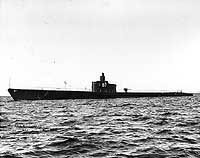![]() The Pacific War Online Encyclopedia
The Pacific War Online Encyclopedia
|
| Previous: Sarangani Bay | Table of Contents | Next: Sariwon |

| Tonnage | 1450 tons standard displacement (surfaced) 2350 tons displacement (submerged) |
| Dimensions | 300' by 27' by 13'9" 91.44 m by 8.23m by 4.19m |
| Maximum speed | 21 knots surfaced 8.75 knots submerged |
| Dive |
to 250 feet to 76 meters |
| Complement | 54 |
| Armament | 8 21" (53cm) torpedo
tubes 1 3"/50 AA gun |
| Machinery |
2-shaft diesel (6140 bhp) or
electric (2740 hp) |
| Bunkerage | 292 tons fuel oil |
| Range | 11,000 nautical miles (20,000 km) at 10 knots surfaced 96 nautical miles (178 km) at 2 knots submerged |
| Modifications |
Some units replaced the 3"
gun
with a 5"/51 gun
during the
war. |
The Sargos were
completed in 1939 and were quite
modern boats. They were essentially slightly modified Salmons, differing
only in some internal arrangements and in having an extra 2' of
length to reduce crowding in the machinery spaces. They were
required
to be able to maintain 17 knots on three of their four diesel
engines
and to have 25 percent reserve buoyancy. Both fore and aft
torpedo tubes could lay mines
(with
stowage for a total of 40 mines). Extra fuel could be carried in
some
of the ballast tanks at the cost of reducing dive capability. The
class
introduced the "down express" ballast tank, which was fitted
under the forward torpedo room to reduce the dive time; this was
flooded at the start of the dive, to pull the boat down, then
blown as
soon as the boat was underwater. However, even with this
assistance, it
took 39 seconds for a boat to reach periscope depth.
The Sargos used a new Navy battery design (Sargo batteries) in place of the commercial batteries previously used. Caisson tests during the mid-1930s had revealed that the hard rubber case used by the commercial batteries was prone to crack when shocked, as by a depth charge. Cracked cells leaked sulfuric acid, which was capable of corroding steel, burning the skin of crew members it came into contact with, and mixing with any seawater in the bilges to generate poisonous chlorine gas. The new battery design consisted of inner and outer hard rubber cases separated by a thin soft rubber membrane that would retain the acid even if the cases were cracked. This significantly increased the survivability of the boats.
The most notorious boat of this class
was Squalus,
which sank during a shakedown cruise in 1939 when the main
induction
valve
jammed for reasons that are still not entirely clear. About
half the crew of Squalus
was successfully rescued from deep water, a first in submarine
history,
and the
boat itself was salvaged and renamed Sailfish.
Sailors being a
superstitious lot with long memories, Sailfish
quickly became known as Squailfish
and was considered an extremely unlucky boat. However, she
survived the
war with an honorable patrol record.
The entire class was deployed to the Philippines in late 1941 as part of Submarine Squadron 20. It was hoped that these modern boats would be able to hinder any Japanese invasion of the Philippines in the event of war. However, a combination of inexperienced boat commanders and crews, poor tactical doctrine, and miserable torpedoes ensured that the boats posed little threat to the invasion convoys. With more experience, better doctrine, and modifications to improve the performance of the Mark XIV torpedo, the boats of the class were credited with a total of 73 enemy ships sunk by the end of the war.
Seawolf racked up an impressive record of 18 enemy ships sunk, only to succumb to friendly fire from aircraft and the destroyer escort Richard M. Rowell. Seawolf was in a designated submarine lane but was a day behind schedule, and the destroyer captain maintained that she had failed to send the correct sonar recognition signal.
The final four units of the class (Seadragon, Seawolf,
Sealion, and Searaven) are sometimes listed as a
separate class. They differed from the earlier units chiefly in
reverting back to all-electric drive from composite drive.
|
Sargo |
||
| Sunk
1943-11-19 by depth
charges and gunfire from
destroyer Yamagumo
|
||
| Disappeared 1945-1-3 in the Ryukyus |
||
| Seadragon | Cavite | Undergoing overhaul when war broke out |
| Sealion | Cavite | Undergoing overhaul when war broke out. Damaged beyond
repair
1941-12-10 by aircraft
while still in dry dock. |
| Searaven | Cavite | |
| Seawolf | Cavite | Sunk 1944-10-3 by U.S. destroyer escort Richard M. Rowell |
References
The Pacific War Online Encyclopedia © 2007, 2009, 2011, 2013 by Kent G. Budge. Index